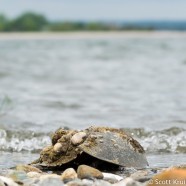July Sunset
Here are a couple sunset photos from last night at Stratford Point as we were on duty providing some fireworks coverage here in Stratford, Milford and West Haven for the Audubon Alliance for Coastal Waterbirds. You can see the reef balls in the distance along our dune and spartina growth in the intertidal zone. We had a couple Black-crowned Night-Heron visitors appropriately join us just after darkness fell on the site. Scott Kruitbosch Conservation & Outreach Coordinator
Read MoreTagged Horseshoe Crab
I found this deceased Horseshoe Crab at Bridgeport, Connecticut’s Pleasure Beach in June. As you can see it has a large tag on it from the U.S. Fish & Wildlife Service. Here along the Connecticut coast Sacred Heart University is studying the Horseshoe Crab through Project Limulus. This effort monitors populations, helps to track individuals by tagging, seeks to better understand their biology, and works to aid the spawning process by protecting the species and educating the public. Learn more by visiting their website! I reported this individual, a male, which I was told was first...
Read MoreGarbage Mentality
It is one cup left on one rock in front of one ocean, and it certainly looks insignificant in this photo, but does the Atlantic really need one more piece of trash? If you are heading to the shore to fish, swim, build sandcastles, enjoy the wildlife, whatever your day may be, please do not leave anything behind. Every little bit does count. I am continually astounded at how many people trash their trash wherever they please around any open water as if the endless horizon will simply swallow it up, and I plan on making this more of a point going forward given all that we at RTPI do to help...
Read MoreHorseshoe Crabs
If you are on the Atlantic Coast during the late spring you may be fortunate enough to find Horseshoe Crabs during the breeding season. Early June, especially around a new or full moon, is a very busy time for these marine arthropods that are considering living fossils, having existed nearly unchanged for approximately 450 million years. These photos were taken at Stratford Point in Stratford, Connecticut, an important mating site at the mouth of the Housatonic River. The females will lay eggs on beaches like this one, some subsequently being eaten by migrant shorebirds. The most vivid...
Read More







